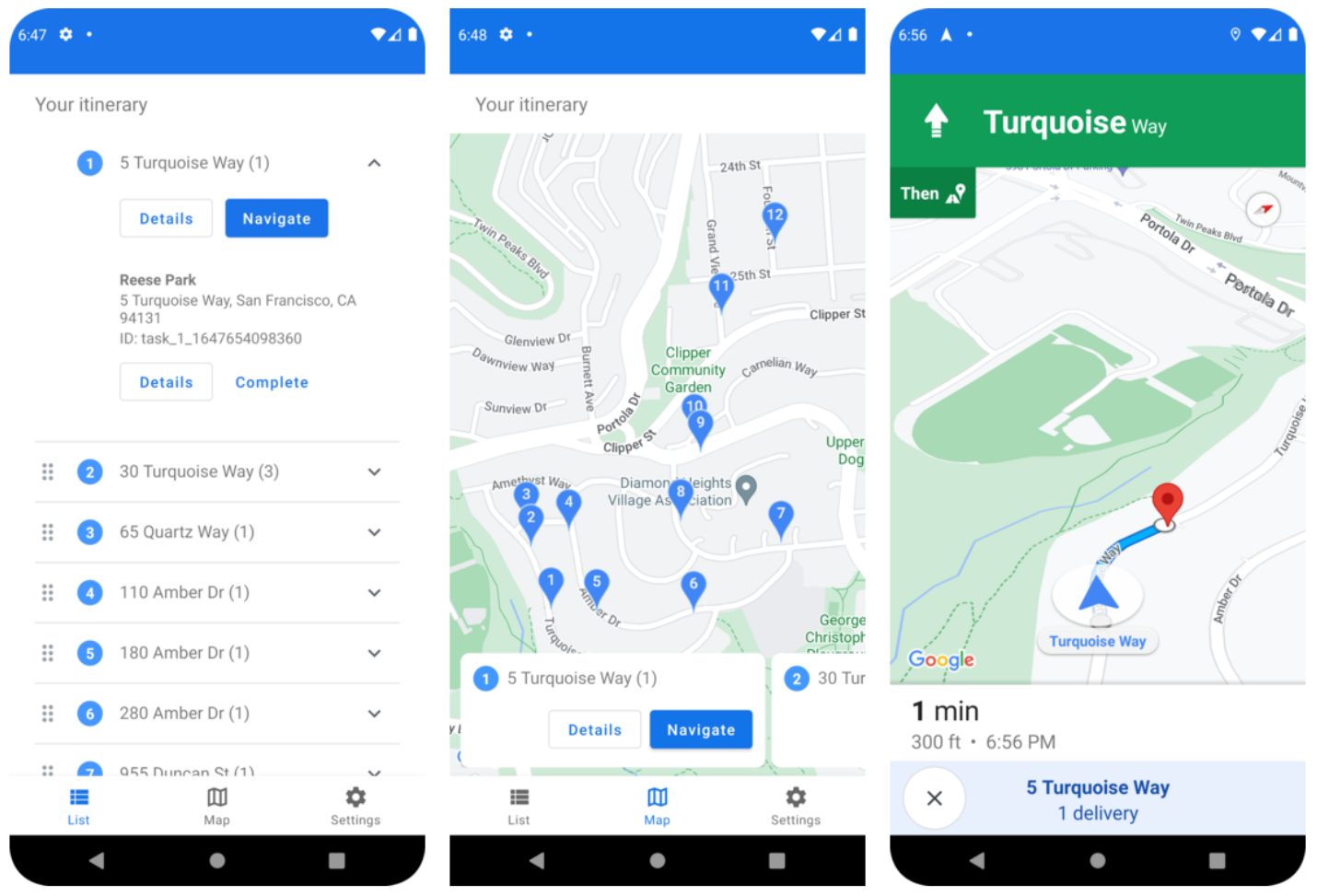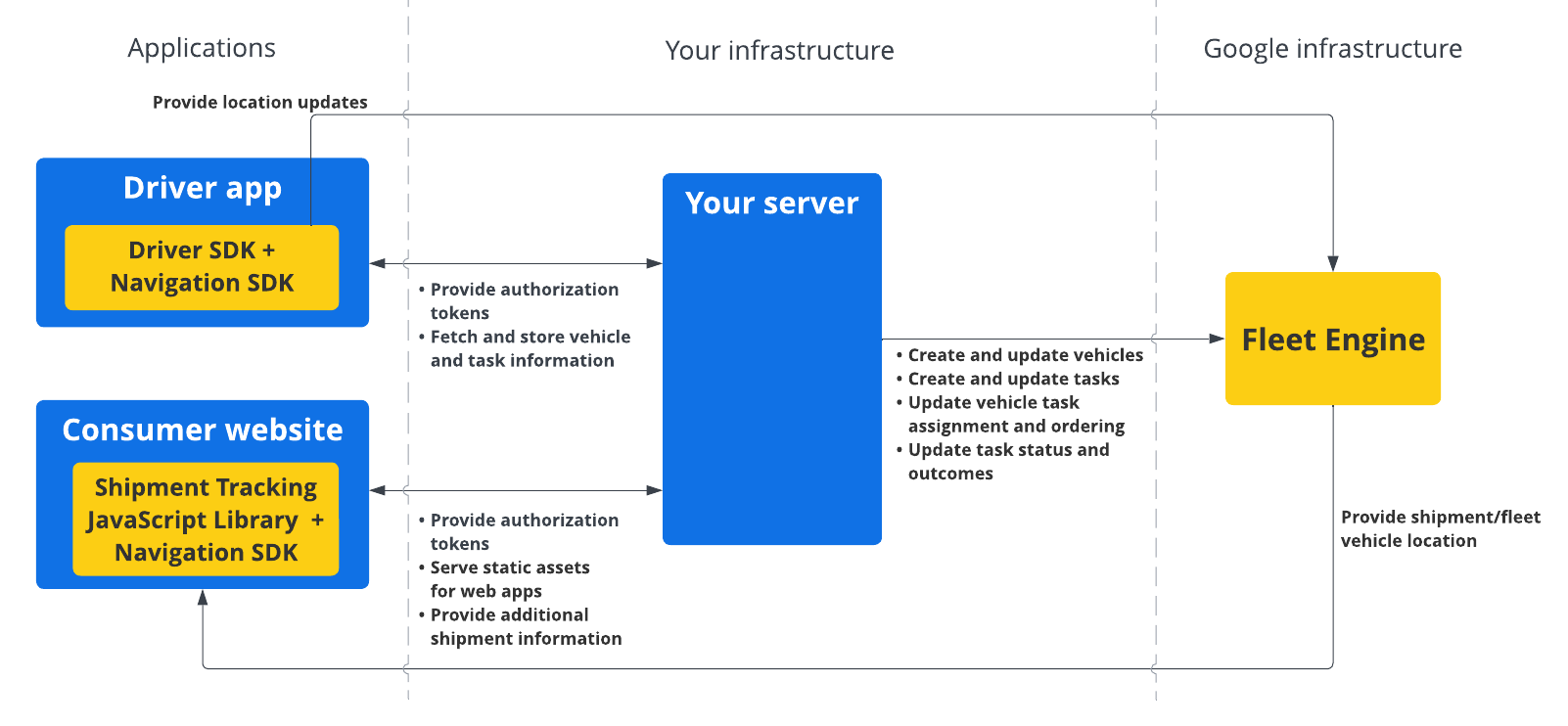
ড্রাইভার SDK হল একটি মোবাইল অ্যাপ টুলকিট এবং ফ্লিট ইঞ্জিনের একটি মৌলিক উপাদান। এই SDK এর সাহায্যে, আপনার ড্রাইভার অ্যাপটি কাজের অ্যাসাইনমেন্ট পরিচালনা করতে পারে এবং ড্রাইভার নেভিগেশন এবং রাউটিং ক্ষমতা সক্ষম করতে পারে।
শুরু করার আগে
এই নির্দেশিকা ধরে নিচ্ছে যে আপনি নিম্নলিখিতগুলি পড়েছেন:
- ফ্লিট ইঞ্জিনের প্রয়োজনীয় বিষয় ।
- যানবাহনের জন্য ডেটা মডেল ।
- নির্ধারিত কাজের জন্য ডেটা মডেল ।
- ফ্লিট ইঞ্জিন কিভাবে সেট আপ করবেন ।
- ফ্লিট ইঞ্জিনে যানবাহন কীভাবে তৈরি এবং ব্যবহার করবেন ।
নির্ধারিত কাজের জন্য ড্রাইভার SDK কী?
ড্রাইভার SDK গাড়ির অবস্থান এবং টাস্ক আপডেট ফ্লিট ইঞ্জিনে যোগাযোগ করে যাতে ফ্লিট ইঞ্জিন ডেলিভারি যানবাহন এবং তাদের নির্ধারিত ডেলিভারি স্টপ এবং কাজগুলি পরিচালনা করতে পারে। এর মূল অংশে, SDK একটি ইভেন্ট লিসেনার ব্যবহার করে অবস্থান আপডেট এবং অক্ষাংশ/দ্রাঘিমাংশ স্থানাঙ্ক পাঠায়, সাথে সাথে বর্তমান রুট সেগমেন্ট এবং গন্তব্য নেভিগেশন SDK থেকে ফ্লিট ইঞ্জিনে যখন আপনার ড্রাইভার গাড়ি চালানো শুরু করে তখন।
নির্ধারিত কাজের জন্য ড্রাইভার SDK কেন ব্যবহার করবেন?
ড্রাইভার SDK ড্রাইভারের রুট আপডেটের জন্য ফ্লিট ইঞ্জিনের সাথে সহজে ইন্টিগ্রেশন সক্ষম করে। এই SDK এর সাহায্যে, আপনার ড্রাইভার একটি একক অ্যাপ ব্যবহার করে অ্যাসাইনমেন্ট পরিচালনা করতে এবং নেভিগেট করতে পারবেন যেমন তারা তাদের Google Maps এর গ্রাহক সংস্করণ ব্যবহার করে কিন্তু অন্য অ্যাপে স্যুইচ না করেই।
নির্ধারিত কাজের জন্য ড্রাইভার SDK দিয়ে আপনি কী করতে পারেন
ফ্লিট ইঞ্জিনের সাথে নিম্নলিখিত যোগাযোগের জন্য নির্ধারিত কাজের জন্য ড্রাইভার SDK ব্যবহার করুন:
- একটি মানচিত্রে ডেলিভারি গাড়ির রিয়েল-টাইম অবস্থান।
- থামার জন্য অক্ষাংশ/দ্রাঘিমাংশ স্থানাঙ্ক।
- স্টপেজের বাকি দূরত্ব।
- স্টপে পৌঁছানোর আনুমানিক সময়।
- নেভিগেশন SDK-এর দেওয়া পথ অনুযায়ী গাড়িটি যে পথে যেতে হবে।
নির্ধারিত কাজের জন্য ড্রাইভার SDK কীভাবে কাজ করে
ড্রাইভার SDK রাউটিং তথ্য এবং গন্তব্যের জন্য নেভিগেশন SDK এর উপর নির্ভর করে। নেভিগেশন SDK থেকে প্রাপ্ত তথ্যের সাথে, ড্রাইভার SDK আপনার ড্রাইভার অ্যাপের সাথে একীভূত হয় এবং ফ্লিট ইঞ্জিনকে অবস্থান আপডেট, অক্ষাংশ/দ্রাঘিমাংশ স্থানাঙ্ক, অবশিষ্ট দূরত্ব এবং ETA সরবরাহ করে। অন্যান্য সমস্ত যানবাহনের ডেটা আপডেট গ্রাহকের ব্যাকএন্ডে পাঠাতে হবে, যা ফ্লিট ইঞ্জিনে ডেটা রিলে করে।

নির্ধারিত কাজের জন্য ড্রাইভার SDK কীভাবে ব্যবহার করবেন
ড্রাইভার SDK ব্যবহার শুরু করার পদ্ধতি দেখতে আপনার প্ল্যাটফর্মটি নির্বাচন করুন।
অ্যান্ড্রয়েড
| ১ | অ্যান্ড্রয়েডের জন্য ড্রাইভার SDK পান | আরও তথ্যের জন্য, ড্রাইভার SDK পান দেখুন। |
| ২ | একটি Google Cloud কনসোল প্রকল্প কনফিগার করুন | আরও তথ্যের জন্য, একটি Google ক্লাউড কনসোল প্রকল্প কনফিগার করুন দেখুন। |
| ৩ | নির্ভরতা ঘোষণা করুন | আরও তথ্যের জন্য, নির্ভরতা ঘোষণা দেখুন। |
| ৪ | প্রমাণীকরণ টোকেন তৈরি করুন | আরও তথ্যের জন্য, প্রমাণীকরণ টোকেন তৈরি করুন দেখুন। |
| ৫ | ড্রাইভার SDK আরম্ভ করুন | আরও তথ্যের জন্য, ড্রাইভার SDK আরম্ভ করুন দেখুন। |
| ৬ | গাড়ি প্রস্তুত রাখুন | আরও তথ্যের জন্য, গাড়ি প্রস্তুত করুন দেখুন। |
আইওএস
| ১ | iOS এর জন্য ড্রাইভার SDK পান | আরও তথ্যের জন্য, ড্রাইভার SDK পান দেখুন। |
| ২ | একটি Google Cloud কনসোল প্রকল্প কনফিগার করুন | আরও তথ্যের জন্য, একটি Google ক্লাউড কনসোল প্রকল্প কনফিগার করুন দেখুন। |
| ৩ | প্রমাণীকরণ টোকেন তৈরি করুন | আরও তথ্যের জন্য, প্রমাণীকরণ টোকেন তৈরি করুন দেখুন। |
| ৪ | ড্রাইভার SDK আরম্ভ করুন | আরও তথ্যের জন্য, ড্রাইভার SDK আরম্ভ করুন দেখুন। |
| ৫ | গাড়ি প্রস্তুত রাখুন | আরও তথ্যের জন্য, গাড়ি প্রস্তুত করুন দেখুন। |
এরপর কি?
আপনি যে প্ল্যাটফর্মে ড্রাইভার SDK সেট আপ করতে চান তার ডকুমেন্টেশন দেখুন:

